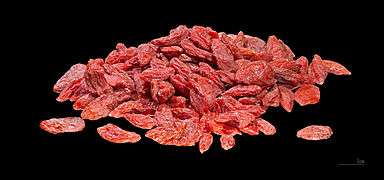Lycium chinense
| Lycium chinense | |
|---|---|
 | |
| Lycium chinense fruits | |
| Scientific classification | |
| Kingdom: | Plantae |
| (unranked): | Angiosperms |
| (unranked): | Eudicots |
| (unranked): | Euasterids I |
| Order: | Solanales |
| Family: | Solanaceae |
| Genus: | Lycium |
| Species: | L. chinense |
| Binomial name | |
| Lycium chinense Mill. | |
| Synonyms[1][2] | |
| |
Lycium chinense is one of two species of boxthorn in the family Solanaceae from which the goji berry or wolfberry is harvested, the other being Lycium barbarum. Two varieties are recognized,[3] L. chinense var. chinense and L. chinense var. potaninii.
It is also known as Chinese boxthorn, Chinese matrimony-vine, Chinese teaplant, Chinese wolfberry, wolfberry,[4] and Chinese desert-thorn.[5]
The plant is used in traditional Chinese medicine for the treatment of nightsweats, pneumonia, cough, hematemesis, inflammation, and diabetes mellitus.
See also
- List of culinary fruits
- List of dried foods
- Sea buckthorn – another medicinal plant that somewhat resembles Wolfberry
- Habitus
- Flower
- Leaves and buds
 Chinese boxthorn, dried fruit - MHNT
Chinese boxthorn, dried fruit - MHNT
References
Further reading
- Books
- Ai, Changshan (2002). Zhi Bu Liang Yi Hua Gou Qi (A Word About Lycium chinense, Effective for Therapy and Nutrition). Changchun, China: Jilin Ke Xue Ji Shu Chu Ban She. ISBN 7-5384-2402-4. ISBN 978-7-5384-2402-7.
- Oyama, Sumita (1964). Kuko o Aishite Junen (Lycium chinense in Favorable Use for Ten Years). Tokyo, Japan: Shufu no Tomosha.
- Shufo no Tomosha (1963). Kuko no koyo (Medicinal and Therapeutic Effects of Lycium chinense). Tokyo, Japan.
- Takayama, Eiji (1966). Jinsei no Honbutai wa Rokujissai Kara: Furo Choju Kuko no Aiyo (The Real Stage in Life Begins at Sixty: Habitual Use of Lycium chinense for Longevity). Tokyo, Japan: Koyo Shobo
- Zhang, Yanbo (2000). Molecular Approach to the Authentication of Lycium barbarum and its Related Species. M. Phil. thesis. Hong Kong, China: Hong Kong Baptist University
External links
| Look up wolfberry or 枸杞子 in Wiktionary, the free dictionary. |
| Wikimedia Commons has media related to Lycium chinense. |
This article is issued from Wikipedia - version of the 12/24/2015. The text is available under the Creative Commons Attribution/Share Alike but additional terms may apply for the media files.